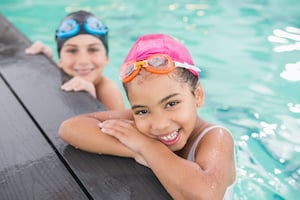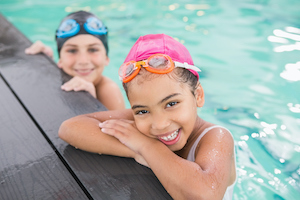 Swimming is an important part of summer, and now that some pools are beginning to reopen, you and your children might be itching to get back in the water. While swimming is a great form of exercise, it comes with risk. Drowning is the second most common cause of death and injury in children ages 14 and under. Here’s what you need to know to keep your children safe in the water.
Swimming is an important part of summer, and now that some pools are beginning to reopen, you and your children might be itching to get back in the water. While swimming is a great form of exercise, it comes with risk. Drowning is the second most common cause of death and injury in children ages 14 and under. Here’s what you need to know to keep your children safe in the water.
Always supervise
Drowning is a risk for any child regardless of age, which is why the American Academy of Pediatrics (AAP) recommends always having an adult supervise when children are in the water. If your child is under 5 years old, an adult should be within arm’s length in the water and should know how to perform CPR.
Consider swim lessons
The American Red Cross recommends that children achieve water competency. That means that your child is able to:
- Jump into water above their head
- Return the to the surface and float or tread water for one minute
- Turn around in a circle to find an exit
- Swim 25 yards to an exit without stopping
- Exit from the water (if in a pool be able to exit the pool without using a ladder)
While items like water wings and other floatables might seem like a good idea if your child isn’t able to swim, it’s recommended they not be used because they can provide a false sense of security, says the AAP. If you want your child to be in the water and they’re not yet water competent, use a Coast Guard-approved life jacket.
Find a swim class near you here.
Know water safety
In addition to being water competent, it’s important to follow safety procedures around pools and bodies of water. Before entering the water, make sure your child knows and will follow all safety rules. These can include things like no diving, running or horseplay and to listening to any lifeguards on duty.
It’s also recommended that your child:
- Know their limitations, including their fitness level or any medical condition that might impair their ability to safely swim
- Never swim alone. Make sure there are lifeguards or a supervisor present
- Understand how to adjust to unique risks in the water environment like rip currents, animals and vegetation, water temperature or shallow or cloudy water.
You can take a free water safety class online from the American Red Cross here.
Know what to do in an emergency
If a child is missing, always check the water first and if a lifeguard is present, alert them as well. A swimmer is in need of help if they:
- Are not making forward progress in the water
- Are vertical in the water, but cannot tread water or move
- Are motionless and facedown in the water
If your child is in danger, remove them from the water and call emergency services if your child is unconscious.







